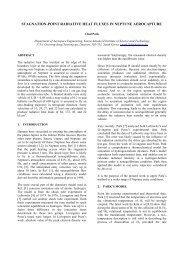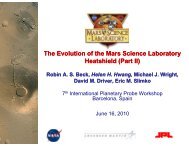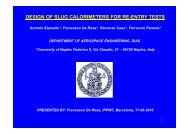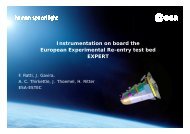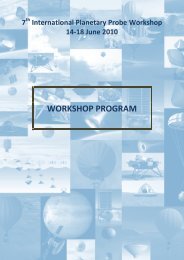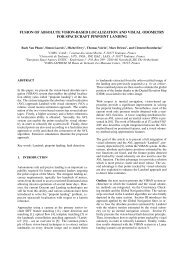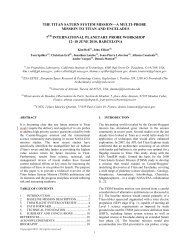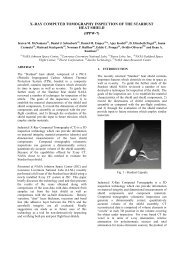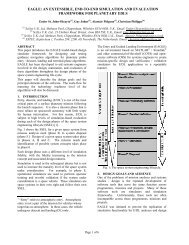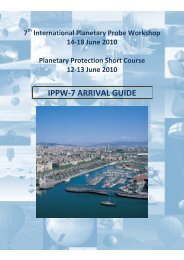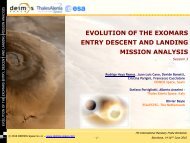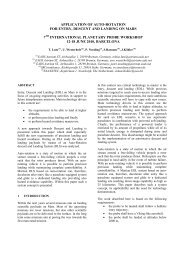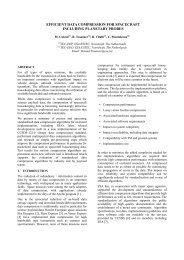Paper 423 - International Planetary Probe Workshop
Paper 423 - International Planetary Probe Workshop
Paper 423 - International Planetary Probe Workshop
You also want an ePaper? Increase the reach of your titles
YUMPU automatically turns print PDFs into web optimized ePapers that Google loves.
1.3 Description of Baseline Launch Decisions<br />
1.2 Grand Menu<br />
In order to examine all possible design paths for the<br />
RICE mission, a Grad Menu was developed and is<br />
shown in Table 1 in the Appendix. The mission was<br />
divided into four sections: Launch, On-Orbit, Re-<br />
Entry, and Recovery.<br />
The launch section covers all driving design<br />
considerations related to the launch, including the<br />
launch vehicle selection, payload class, launch adapter,<br />
and the launch priority. The on-orbit section largely<br />
covers the service module and payload design. Within<br />
the service module design, considerations exist for<br />
each subsystem, while the payload design focuses on<br />
payload requirements that affect the RICE interface<br />
with the CubeSat. The on-orbit section also includes<br />
the orbit for the RICE mission, including the range of<br />
altitudes and eccentricities considered in the mission<br />
design. The re-entry section focuses on all design<br />
considerations associated with the entry, descent, and<br />
landing portion of the mission. This encompasses the<br />
deceleration method (parachute vs. impact sphere), the<br />
aeroshell geometry, landing footprint, TPS, and<br />
stabilization method for the hypersonic portion of reentry.<br />
Finally, the recovery section covers the entry<br />
vehicle landing and recovery portion of the mission<br />
and all design considerations that affect it. This<br />
includes the baselined landing site, the recovery time<br />
set by the payload requirements, the recovery method,<br />
and the tracking method.<br />
Within the Grand Menu, certain design considerations<br />
have already been eliminated (shown in red) or<br />
baselined (shown in green). Design option elimination<br />
and baseline selections will be explained in the<br />
following section for the design decisions that have the<br />
largest effect on the overall mission and flight system<br />
architecture.<br />
The primary driver of the launch vehicle decisions is<br />
the spacecraft mass and the total mission cost, because<br />
one of the mission objectives of RICE is to keep the<br />
mission as simple as possible. Therefore, the RICE<br />
launch priority was selected to be secondary, because<br />
of the large reduction in mission cost. As a baseline,<br />
the payload class was selected to be the NanoSat, 30 kg<br />
class, because the estimated flight system mass was<br />
within this range. The NanoSat class requires the RSA<br />
launch interface, so it too was chosen as part of the<br />
baseline design. The FalconSat class was eliminated<br />
because the maximum launch payload mass was lower<br />
than the RICE estimated mass.<br />
This largely affects the mass and volume constraints<br />
placed on the flight system. As a NanoSat class<br />
payload, the maximum mass must not exceed 30kg and<br />
the volume must not exceed a cylinder with a diameter<br />
and height of 18.7 inches. The Ride-Share Adapter<br />
(RSA) also requires that the spacecraft be interfaced<br />
using a Lightband attachment and that the payload not<br />
interfere with the survival of the primary payload.<br />
Figure 3 shows the RSA adapter in which the RICE<br />
flight system would occupy the central, octagonal<br />
volume.<br />
Figure 3. RSA with payload envelope [1]<br />
1.4 Description of Baseline Orbit Decisions<br />
For the baseline mission orbit, the simplest case was<br />
selected: low-earth, circular orbit. The range of<br />
altitudes examined was determined by a study of the<br />
de-orbit burn and its effect on the amount of propellant<br />
required, the landing footprint, and the re-entry heat<br />
load. From a study of the de-orbit delta V and the<br />
required propellant (shown in Figure 4), the propellant<br />
mass for the range of -3 to -4 degrees was found to be<br />
relatively constant for orbits between 300km and<br />
1000km. Therefore, that range of altitudes was chosen<br />
as the baseline to be examined in all future analyses.



